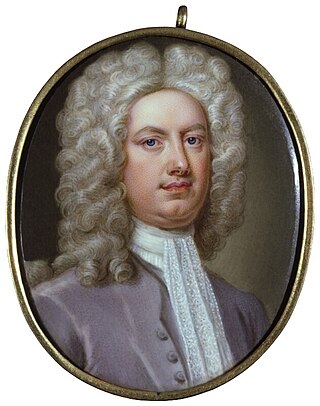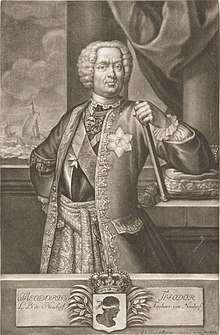
1736 (MDCCXXXVI) was a leap year starting on Sunday of the Gregorian calendar and a leap year starting on Thursday of the Julian calendar, the 1736th year of the Common Era (CE) and Anno Domini (AD) designations, the 736th year of the 2nd millennium, the 36th year of the 18th century, and the 7th year of the 1730s decade. As of the start of 1736, the Gregorian calendar was 11 days ahead of the Julian calendar, which remained in localized use until 1923.

Filippo Antonio Pasquale de' Paoli was a Corsican patriot, statesman, and military leader who was at the forefront of resistance movements against the Genoese and later French rule over the island. He became the President of the Executive Council of the General Diet of the People of Corsica and wrote the Constitution of the state.

Patrick Sarsfield, 1st Earl of Lucan was an Irish soldier and Jacobite. Killed at Landen in 1693 while serving in the French army, he is now best remembered as an Irish patriot and military hero.

Horatio Walpole, 1st Baron Walpole, was an English diplomat, politician and peer who served as the British ambassador to France from 1724 to 1730. He was the son of Robert Walpole and the younger brother of Robert Walpole, the first Prime Minister of Great Britain.

Juan Guillermo, Baron de Ripperdá, 1st Duke of Ripperdá, was a political adventurer and Spanish Prime Minister.

Corsica is an island in the Mediterranean Sea and one of the 18 regions of France. It is the fourth-largest island in the Mediterranean and lies southeast of the French mainland, west of the Italian Peninsula and immediately north of the Italian island of Sardinia, the nearest land mass. A single chain of mountains makes up two-thirds of the island. As of January 2024, it had a population of 355,528.

The history of Corsica in the medieval period begins with the collapse of the Western Roman Empire and the invasions of various Germanic peoples in the fifth century AD, and ends with the complete subjection of the island to the authority of the Bank of San Giorgio in 1511.

The history of Corsica goes back to antiquity, and was known to Herodotus, who described Phoenician habitation in the 6th century BCE. Etruscans and Carthaginians expelled the Phoenicians, and remained until the Romans arrived during the Punic Wars in 237 BCE. Vandals occupied it in 430 CE, followed by the Byzantine Empire a century later.

Christian IV, Count Palatine of Zweibrücken-Birkenfeld was Duke of Zweibrücken from 1735 to 1775.

Rogliano is a commune in the French department of Haute-Corse, Corsica.

The Treaty of Versailles was a treaty concluded on 15 May 1768 at Versailles between the Republic of Genoa and France, in which Genoa ceded Corsica to France.

The Kingdom of Corsica was a short-lived kingdom on the island of Corsica. It was formed after the islanders crowned the German adventurer Theodor Stephan Freiherr von Neuhoff as King of Corsica.

The Invasion of Corsica of 1553 occurred when French, Ottoman, and Corsican exile forces combined to capture the island of Corsica from the Republic of Genoa.

The French conquest of Corsica was a successful expedition by French forces of the Kingdom of France under Comte de Vaux, against Corsican forces under Pasquale Paoli of the Corsican Republic. The expedition was launched in May 1768, in the aftermath of the Seven Years' War. A French expeditionary force was landed on the island of Corsica, then ruled by the Corsican Republic. Marching inland to overcome any Corsican opposition, the French force initially suffered an unexpected defeat at the Battle of Borgo. But a new commander, the Comte de Vaux, was appointed to lead the expedition, and decisively defeated the Corsican army at the Battle of Ponte Novu in 1769, effectively bringing an end to Corsican resistance.

Honora Burke became Honora FitzJames, Duchess of Berwick on Tweed, married Patrick Sarsfield and went into French exile where he followed her soon afterwards. After his death at the Battle of Landen, she married James FitzJames, 1st Duke of Berwick, an illegitimate son of James II. She may have introduced the country dance to the French court.
Catalina Sarsfield, also styled Catalina von Neuhoff and briefly as Catalina of Corsica, was queen of Corsica by marriage to Theodore of Corsica, who ruled the short-lived Kingdom of Corsica in 1736.
David Sarsfield (1663–1710) was an Irish soldier noted for his service in the Jacobite Army during the Williamite War in Ireland. After going into exile as part of the Flight of the Wild Geese, he later served in the Spanish Army. He was killed at the Battle of Villaviciosa in 1710.
Dominick Sarsfield, 4th Viscount Sarsfield was an Irish aristocrat and supporter of the Jacobite cause during the Williamite War in Ireland.
James King, 4th Baron Kingston was a British member of the peerage. King was a prominent freemason, being the Grand Master of the Premier Grand Lodge of England for 1728–1730 and also Grand Master of the Grand Lodge of Ireland for 1731–1732 and 1735–1736. He was also a member of the Privy Council of Ireland. Despite being born in France to Jacobite parents, he was naturalised at the age of 13 years old on 8 January 1707 as a British subject and was a Protestant.

The Marquessate of Groppoli, in Tuscany and Liguria, was ruled by the House of Brignole-Sale, an illustrious patrician family of Genoa who were its sovereigns from 1592 to 1774.

















